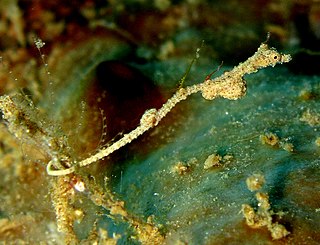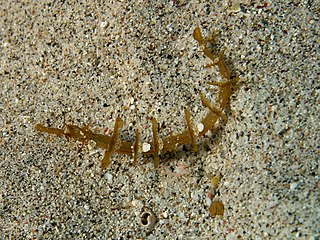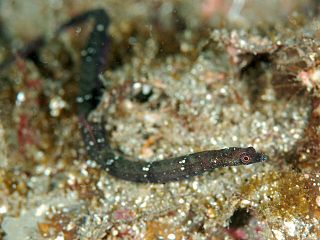
The thread pipefish, also known by its Japanese standard name Hari-youji, is a species of pipefish native to the Pacific Ocean around Indonesia, where it is found at depths from 15 to 20 m. This species grows to a length of 2.68 cm (1.06 in), and is the only known member of its genus.

Halicampus macrorhynchus or also commonly known as the ornate pipefish , whiskered pipefish or winged pipefish is a species of fish in the family Syngnathidae.
Corythoichthys insularis is a species of marine fish in the family Syngnathidae. It is found in the western Indian Ocean, from the Amirante and Comoros islands to the Maldives. It inhabits coral and rocky reefs at depths of 20 to 45 metres, where it can grow to lengths of 10 centimetres (3.9 in). This species is ovoviviparous, with sexual maturity being reached at 8.2 centimetres (3.2 in). The male carries the fertilised eggs in a brood pouch located under his tail.

Corythoichthys nigripectus is a species of marine fish of the family Syngnathidae. It is found in the Indo-Pacific, from the Red Sea, Indonesia and the Philippines to the Society Islands, Guam and New Caledonia. It inhabits coral reefs and algae patches at depths of 5–30 metres (16–98 ft), where it can grow to lengths of 11 centimetres (4.3 in). This species is both monogamous and ovoviviparous, with males carrying eggs and giving birth to live young.
Corythoichthys paxtoni, commonly known as Paxton's pipefish, is a species of marine fish of the family Syngnathidae. It is endemic to the Coral Sea, being found in the Great Barrier Reef, the Chesterfield Islands, and New Caledonia. It inhabits coral reefs and rubble lagoons to depths of 18 metres (59 ft), where it can grow to lengths of 13 centimetres (5.1 in). This species mates monogamously and is ovoviviparous, with males carrying eggs until giving birth to live young.
Cosmocampus howensis is a species of marine fish of the family Syngnathidae. It is found in the South Pacific from Jervis Bay to Easter Island. It lives in lagoons and on rocky reefs, where it grows to lengths of 10–12 centimetres (3.9–4.7 in). It is expected to feed on small crustaceans, similar to other pipefishes. This species is ovoviviparous, with males carrying eggs before giving birth to live young.

Dunckerocampus multiannulatus is a species of marine fish of the family Syngnathidae. It is widespread in the Indian Ocean, from the Red Sea and South Africa to the Andaman Islands and Sumatra, Indonesia. It inhabits coral and rocky reefs to depths of 45 metres (148 ft), where it can grow to lengths of 18 centimetres (7.1 in). It is an active cleaner, feeding on small crustaceans that grow on other fishes. This species is ovoviviparous, with males carrying eggs and giving birth to live young. Males may brood at 13 centimetres (5.1 in).

Booth's pipefish is a species of marine fish of the family Syngnathidae. It is found in the Western Indian Ocean, in South Africa and the Comoro Islands, and in the Western Pacific, from South Korea and Japan to the Great Barrier Reef and Tonga. It lives in rocks and coral reefs to depths of 30 metres (98 ft), where it can grow to lengths of 17.5 centimetres (6.9 in). This species is ovoviviparous, with males carrying eggs and giving birth to live young.

Halicampus brocki, the tasselled pipefish, or Brock's pipefish, is a species of marine fish of the family Syngnathidae. It is found in the Indo-Pacific, from southern Japan, Guam and the Marshall Islands to the central east and west coasts of Australia. It lives on coral and rocky reefs with algae, to depths of 45 metres (148 ft). It can grow to lengths of 12 centimetres (4.7 in), and is expected to feed on small crustaceans, similar to other pipefish. This species is ovoviviparous, with males carrying eggs and giving birth to live young.
Gray's pipefish, also known as the mud pipefish or spiny pipefish is a species of marine fish of the family Syngnathidae. It is found in the Indo-Pacific in the Gulf of Aden, Sri Lanka, and from the Gulf of Thailand to Japan, the Marshall Islands, and the Great Barrier Reef. It lives to depth of 100 metres (330 ft), and planktonic juveniles have been found above depths of 3,000 metres (1.9 mi). It occurs in muddy habitats, in estuaries, and on coral reefs, where it likely feeds on small crustaceans. It can grow to lengths of 20 centimetres (7.9 in). This species is ovoviviparous, with males carrying eggs in a brood pouch before giving birth to live young.
The spinysnout pipefish is a species of marine pipefish of the family Syngnathidae. It is found in the Indo-Pacific, from Sri Lanka to Samoa, and from Japan and the Marshall Islands to central Australia. It lives in rocky and coral reefs, rubble, lagoons and intertidal zones, often at depths of 2–12 metres (6.6–39.4 ft), where it can grow to lengths of 12 centimetres (4.7 in). It is expected to feed on small crustaceans, similar to other pipefish. This species is ovoviviparous, with males carrying eggs in a brood pouch before giving birth to live young.
Microphis insularis, also known as the Andaman pipefish, is a species of freshwater pipefish belonging to the family Sygnathidae. This species is found only in rivers and streams located in the Andaman Islands, India. They can reach 16 cm (6.3 in) in length and reproduce through ovoviviparity, in which males carry eggs and give live birth. The Andaman pipefish is considered threatened likely due to the effects of habitat degradation, invasive species, and the alteration of flow of its freshwater habitats.
Phoxocampus belcheri, also known as the rock pipefish, is a species of marine fish belonging to the family Syngnathidae. The species can be found in shallow reefs and tide pools throughout much of the Indo-Pacific ranging from the eastern coast of Africa and the Red Sea to Tonga and Japan. Its diet likely consists of small crustaceans such as copepods. Reproduction occurs through ovoviviparity in which the males brood eggs before giving live birth.
Phoxocampus diacanthus, also known as the obscure pipefish or spined pipefish, is a species of marine fish belonging to the family Sygnathidae. It can be found inhabiting reefs throughout the Indo-Pacific from Japan and Sri Lanka to Samoa and New Caledonia in the south. Its diet likely consists of small crustaceans. Reproduction occurs through ovoviviparity in which the males brood eggs before giving live birth.

Trachyrhamphus bicoarctatus, also known as the double-ended pipefish is a species of marine fish belonging to the family Syngnathidae. They can be found in reefs, seagrass beds, and sandy habitats throughout the Indo-Pacific from East Africa to New Caledonia and from Japan to Australia. Males of this species are considered mature when they reach approximately 26 centimeters long, but adults can grow to be lengths of 40 centimeters. Reproduction occurs through ovoviviparity in which males brood eggs before giving live birth.
Trachyrhamphus longirostris, also known as the long-head pipefish or straightstick pipefish, is a species of marine fish belonging to the family Syngnathidae. They can be found in muddy estuaries on the continental shelf throughout the Indo-Pacific from Eastern Africa to the Solomon Islands and Japan. The diet of Trachyrhamphus longirostris likely consists of small crustaceans. Adult individuals can grow to be approximately 33 centimeters in length. Reproduction occurs through ovoviviparity in which males brood eggs before giving live birth.
Pseudophallus elcapitanensis is a species of marine fish belonging to the family Syngnathidae. They can be found within freshwater rivers and streams in Central America from Jimenez, Costa Rica to Rio Chico, Panama.
Pseudophallus starksii, also known as the yellowbelly pipefish is a species of marine fish belonging to the family Syngnathidae. They can be found in freshwater streams, rivers, and estuaries ranging from the west coast of Baja California to Ecuador. Reproduction occurs through ovoviviparity in which the males brood eggs before giving live birth.
Nannocampus weberi, also known as the reef-flat pipefish is a species of marine fish belonging to the family Syngnathidae. They can be found inhabiting reefs in the Lesser Sunda Islands of Indonesia particularly the islands of Sumba and Bali. Their diet likely consists of small crustaceans such as copepods. Reproduction occurs through ovoviviparity in which the males brood eggs before giving live birth.
Vanacampus margaritifer, also known as the mother-of-pearl pipefish is a species of marine fish belonging to the family Syngnathidae. They can be found inhabiting seaweed and seagrass beds in addition to rocky reefs along the southern and eastern coast of Australia from Brisbane to Perth. Their diet likely consists of small crustaceans. Reproduction occurs through ovoviviparity in which the males brood eggs before giving live birth.







